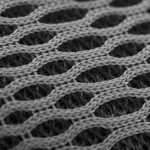Curious about whether satin fabric is hypoallergenic? Let's delve into the world of fabrics and allergies.
Satin, with its smooth and luxurious feel, may seem like an ideal choice, but is it truly safe for sensitive skin? Understanding the characteristics of satin fabric and its potential allergens is essential for making informed decisions about your clothing and bedding.
By exploring the relationship between satin fabric and skin sensitivity, you can learn how to navigate the world of hypoallergenic textiles. Stick with us to uncover tips for using satin safely and discover alternative fabrics that may be more suitable for allergy-prone individuals.
Key Takeaways
- Satin fabric may contain dyes and chemical finishes that can cause skin irritation.
- Synthetic fibers in some satin fabrics can irritate sensitive skin.
- Weave of satin fabric can trap moisture and lead to the growth of bacteria and fungi.
- Consider alternative fabrics like organic cotton, silk, or bamboo for hypoallergenic properties.
Understanding Hypoallergenic Fabrics
Understanding hypoallergenic fabrics involves choosing materials that minimize the risk of triggering allergic reactions. When it comes to hypoallergenic materials, it's crucial to opt for skin-friendly textiles that are less likely to cause irritation. Hypoallergenic fabrics are designed to be gentle on the skin, making them suitable for those with sensitive skin or allergies.
These materials are often free from potential irritants such as harsh dyes, chemicals, and synthetic additives that can commonly cause skin reactions. Fabrics like organic cotton, bamboo, linen, and silk are known for their hypoallergenic properties, as they're naturally breathable and less likely to harbor dust mites or mold, which are common allergens.
When selecting hypoallergenic materials, it's important to consider the weave and texture of the fabric as well. Tight weaves can prevent allergens from penetrating the fabric, while smoother textures may be less abrasive to sensitive skin.
Characteristics of Satin Fabric
When considering satin fabric for hypoallergenic purposes, you'll find that its smooth and lustrous surface distinguishes it from other textiles. Satin fabric offers a luxurious and elegant feel, making it a popular choice for various garments and household items.
Here are some characteristics of satin fabric that make it stand out:
- Smooth Texture: The smoothness of satin fabric not only feels pleasant against the skin but also reduces the likelihood of irritation, making it suitable for those with sensitive skin.
- Lustrous Sheen: Satin's glossy appearance adds a touch of sophistication to clothing and bedding, elevating the overall aesthetic appeal of the fabric.
- Breathability: Satin fabric allows for adequate airflow, preventing excessive heat retention and keeping the body cool and comfortable.
- Durability: Despite its delicate appearance, satin fabric is surprisingly durable, maintaining its quality and luster even after multiple washes.
- Maintenance: Proper care and maintenance, such as gentle washing and avoiding direct heat, can help prolong the lifespan and beauty of satin fabric.
Understanding these characteristics can help you appreciate the benefits of satin fabric and ensure that you can properly care for it to maintain its quality.
Potential Allergens in Satin
If you have sensitive skin, you might be wondering about potential allergens in satin fabric.
Satin can sometimes contain synthetic fibers, dyes, or finishing chemicals that could potentially trigger allergic reactions.
Understanding the potential allergens in satin is important for those with skin sensitivities.
Satin and Allergens
Be aware of potential allergens in satin, as they can contribute to allergic reactions in sensitive individuals.
When considering satin and allergens, it's important to note that some people can be sensitive to the materials used in satin fabric. Here are some potential allergens to consider:
- Dyes: Some dyes used in satin fabric may contain chemicals that can cause skin irritation or allergic reactions.
- Chemical finishes: Certain chemical finishes applied to satin fabric for sheen or texture enhancement may trigger allergies in some individuals.
- Synthetic fibers: Satin made from synthetic fibers like polyester or nylon may cause skin irritation or allergic reactions in sensitive individuals.
- Residual substances: Residues from the manufacturing process, such as formaldehyde, may linger in satin fabric and cause allergic reactions.
- Dust mites: Satin can attract dust mites, which are a common allergen for many people.
Understanding these potential allergens can help individuals make informed choices when selecting satin products.
Satin and Skin Reactions
How can satin fabric potentially trigger skin reactions in sensitive individuals? Satin fabric, while luxurious and smooth, can potentially cause allergic reactions or skin sensitivity in some people. The weave of satin fabric can sometimes trap moisture, leading to an increase in the growth of bacteria and fungi, which may exacerbate skin conditions or cause allergic reactions. Additionally, the synthetic fibers in some satin fabrics can irritate sensitive skin. For those with skin sensitivities, it may be beneficial to consider alternative fabric options that are less likely to cause skin reactions, such as organic cotton, silk, or bamboo fabric. Here's a table summarizing potential allergens in satin fabric:
| Potential Allergens in Satin Fabric |
|---|
| 1. Synthetic fibers |
| 2. Trapped moisture |
| 3. Chemical dyes |
Satin Fabric and Skin Sensitivity
If you have sensitive skin, you may be wondering if satin fabric is a good choice for you. Let's explore how satin interacts with different skin types and what options are available for those with skin sensitivities.
From potential allergens to skin-friendly satin choices, there's a lot to consider when it comes to satin fabric and your skin.
Satin and Allergies
Satin fabric can exacerbate skin sensitivity and allergies in some individuals, especially if you have a history of reactions to certain textiles. If you're prone to allergies, it's essential to consider the potential impact of satin fabric on your skin.
Here are some factors to keep in mind:
- Satin's smooth texture may reduce friction, but it can also trap heat and moisture against the skin, leading to irritation.
- Chemical treatments and dyes used in satin production can cause allergic reactions in sensitive individuals.
- Tight-fitting satin clothing may aggravate existing skin conditions or cause chafing, leading to discomfort.
- Laundering satin with harsh detergents or fabric softeners can leave residue that triggers skin reactions.
- Opting for organic or OEKO-TEX certified satin fabric may reduce the risk of allergic reactions.
Skin-Friendly Satin Options
Consider seeking out satin fabric made from natural fibers to minimize the risk of skin irritation and allergic reactions. When it comes to sensitive skin options, silk alternatives such as mulberry silk or bamboo satin can be excellent choices. These natural fibers are gentle on the skin, breathable, and less likely to cause irritation. Here's a comparison of different skin-friendly satin options:
| Satin Fabric | Material | Benefits |
|---|---|---|
| Mulberry Silk | Natural protein | Hypoallergenic, smooth texture |
| Bamboo Satin | Bamboo fibers | Soft, moisture-wicking, suitable for eczema |
| Organic Cotton | Cotton plant | Breathable, soft, suitable for all skin types |
Opting for satin made from these materials can provide comfort and luxury without compromising on skin health.
Tips for Allergy-Safe Satin Use
To ensure allergy-safe satin use, incorporate hypoallergenic detergent when washing the fabric. This will help to remove any potential allergens that could cause irritation to sensitive skin. In addition to using hypoallergenic detergent, consider the following tips for allergy-safe satin use:
- Wash satin bedding and clothing regularly to remove dust, pollen, and other allergens that may have accumulated.
- Consider using a protective cover for satin pillows and mattresses to create a barrier against dust mites and other allergens.
- Opt for satin made from natural fibers such as silk, as it's less likely to trigger allergic reactions compared to synthetic satin.
- Avoid using fabric softeners or dryer sheets when laundering satin, as these products can contain fragrances and chemicals that may cause allergies.
- If you have severe allergies, consider consulting with an allergist to determine if satin is a suitable fabric for your specific sensitivities.
Alternatives to Satin for Allergies
If you experience allergies or sensitivities to satin fabric, you may want to explore alternative materials that are less likely to trigger allergic reactions.
Satin alternatives such as organic cotton, bamboo, and microfiber can be great options for those with allergies.
Organic cotton is a breathable and hypoallergenic fabric that's gentle on the skin, making it a suitable alternative to satin.
Bamboo fabric is another excellent choice as it's naturally antibacterial, moisture-wicking, and soft, providing comfort without causing allergic reactions.
Additionally, microfiber, a synthetic fabric made from finely woven fibers, is often considered allergy-friendly due to its smooth texture and resistance to dust mites and allergens.
These satin alternatives offer a range of options for individuals seeking allergy-friendly fabrics.
When selecting alternatives to satin, it's important to consider the specific sensitivities and preferences of your skin to ensure the chosen fabric will be comfortable and non-irritating for you.
Conclusion and Final Thoughts
In conclusion, when selecting a fabric that's hypoallergenic, it's important to carefully consider your specific sensitivities and preferences to ensure the chosen material will be comfortable and non-irritating for you. Exploring alternatives and allergen-free options can provide a range of choices for those with allergies or sensitive skin.
Here are some final thoughts to consider:
- Natural Fibers: Opt for natural fabrics such as cotton, silk, or bamboo, which are known for being hypoallergenic and gentle on the skin.
- Thread Count: Look for fabrics with a high thread count, as this can indicate a tighter weave that's less likely to trap allergens.
- Dye-Free Options: Consider fabrics that are free from harsh dyes and chemicals, as these can be potential allergens for sensitive individuals.
- Moisture-Wicking Materials: Explore moisture-wicking fabrics like microfiber or certain blends that can help manage sweat and reduce the risk of skin irritation.
- Organic and Eco-Friendly Choices: Consider organic and eco-friendly options, as they're often produced without the use of harsh chemicals and may be more suitable for sensitive individuals.
Frequently Asked Questions
Can Satin Fabric Cause Allergic Reactions in People With Sensitive Skin?
When you have sensitive skin, satin fabric can potentially cause skin irritation and allergic reactions due to its smooth texture and potential allergen exposure. Look for hypoallergenic brands and pay attention to fabric care during satin production.
Are There Specific Types of Satin Fabric That Are More Hypoallergenic Than Others?
Yes, there are specific types of satin fabric that are more hypoallergenic than others. Silk satin is a natural and breathable option, while polyester satin may be less hypoallergenic due to its synthetic nature.
How Should Satin Fabric Be Properly Cared for to Minimize Allergen Exposure?
To properly care for satin fabric and minimize allergen exposure, store it in a cool, dry place away from direct sunlight. Avoid fabric softeners, as they can diminish its hypoallergenic properties and cause allergic reactions, especially for sensitive skin.
Are There Any Additional Steps That Can Be Taken to Make Satin Fabric Even More Allergy-Safe?
To make satin fabric even more allergy-safe, consider additional treatments like hypoallergenic washing or using satin alternatives such as silk or bamboo. These options can help minimize allergen exposure and provide a more comfortable experience.
Are There Any Specific Brands or Manufacturers That Are Known for Producing Hypoallergenic Satin Fabric?
When looking for hypoallergenic satin fabric, it's essential to seek out reputable brands known for producing allergy-friendly materials. Researching which brands specifically cater to eczema sufferers can also help you find the best options for your needs.
- How Does Ring Spun Cotton Affect Garment Fit and Shape Retention? - August 13, 2024
- What Are the Challenges in Producing Ring Spun Cotton? - August 13, 2024
- Is Ring Spun Cotton Suitable for Plus-Size Clothing? - August 13, 2024




